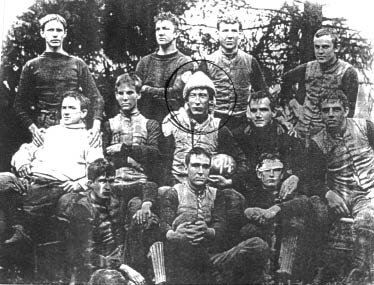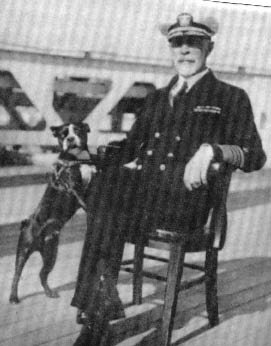
Discover rewarding casino experiences. 
|
The doctors giving Reeves this warning were at the U.S. Naval Academy where he was a cadet in 1892. He believed he could develop some sort of head protection like, say, a football helmet. This being “Football Bowl Season” this week, we scanned the files for some football related story and, as it turns out, this is an important one because the “inventor” of the helmet is said to be Joseph Reeves, a native of Tampico, right here in Northwest Illinois. However well-known “Bull” Reeves was for his passionate style of playing the game, and the fact that he later became head football coach at the Naval Academy, he was far more famous for the contributions he made as an officer in the Navy, eventually rising to admiral, but also for the fact that this persistence and drive forwarded the navy air force at its very beginning. Because of his record of daring and perception, he runs a very close second in renown to another Tampico native, Ronald Reagan, president of the United States of America. Born in Tampico, Illinois November 20, 1872, his father was a farmer-schoolteacher and had won some local fame during the Civil War by being in the U.S. Cavalry. He is buried in the Tampico Cemetery. “Bull” Reeves, undoubtedly, for his strong-mindedness, achieved no small number of credits during his long naval career after graduating from the Academy in 1894. Football was becoming very popular in the 1890’s with teams being formed everywhere and schools, secondary through colleges organizing schedules to play one another. The first of the “official” rules, however, had been laid out in 1863 and games had been played long before that in the United States though not monitored at all. At Princeton University, New Jersey, a game called “ballown” had been played in 1820, though hardly similar to today’s game. The sport had migrated to our shores from Britain or the Continent in the usual way of things with each region and area, there and here, having its own interpretation. It was somewhat an avidly followed game from before the thirteenth century. Even during the Roman occupation they played a game called harpastum that could be said to resemble football although the name had no ring to it! It meant handball. The sport may have been merely the result of children playing with an inflated bladder os some animal of any shape, they kicking, throwing or pushing the “ball” to a line, a goal or to some object behind the opponents band. There was really no set number of players in those early days and the gatherings were called melees or mallays, quite appropriate.
As the decades passed rules, strategies and plans changed, of course, and was so popular that it occupied the very souls and thoughts of the young crowd especially. Heads of armies, even royalty began to worry about the boys and men of military age being more interested in football than practicing their archery for warfare. During several reigns of kings, football was attempted to be banned even unto the days of King Henry VIII and Queen Elizabeth I. Out there on the lonely heather and in the remote Highlands, football went on at every opportunity and target shooting with arrows lagged! Football had become so popular in Scotland that another game just getting its start was nearly abandoned and those promoting “gowffe” took second in playing time! Annual games were celebrated on Shrove Tuesday being a traditional day for playing the sport much like New Year’s Day is game now in the U.S. One of the annual games in Scotland, for instance, was played by the women of the parish, the married against the spinsters. Source gives that the married women won most every game. What a melee that must have been. As years passed, football wasn’t just played at festival times and the archers were disciplined into better aim, more rules that made the mallays less violent took place though the games had only a bare resemblance to today’s sport. One of the differences was twenty-five men on a side. Later it was reduced to fifteen and then finally eleven but that’s fairly recent. There is also a six man football where numbers of players are sparse. In fact, there’s many different games, varying widely from the United States, Canada, Australia, Britain, the Gaelic and all over the world. Of course, there’s Rugby and Soccer and other games with other names but similar in some ways ... No hands, no throwing, no helmets. The transformation of the game is lengthy, fascinating and complex. Professional football has a chapter, too. Little more than a hundred years ago the football helmet came into use because Joseph Reeves didn’t want to risk his sanity or his life. He went to an Annapolis shoemaker and together they contrived a somewhat padded helmet of leather from the shoemaker’s stock of leather and it is believed that the first such helmet was worn at an Army-Navy game in 1893. A ground-breaking though apparently no head knocking milestone. The leather helmet also served as a pattern for the first aviators cap, a close fitting, strapped affair and which Reeves might have promoted because of his growing interest in aviation. Joseph Reeves rose through the ranks of the U.S. Navy and served in many important assignments. Commanding for instance, the U.S.S. Maine during World War I at which time he won the Navy Cross for “exceptional meritorious service.” Prior to the Main experience he had served aboard the U.S.S. Oregon in the Pan-American War, the ship shelling and destroying Spanish fleet at Santiago Harbor, Cuba in 1898. Following W.W. I there were a few quiet years until in 1923 he went to the Naval War College. He became engrossed with the possibilities of what navy aviation was capable of in expanding its capabilities ... Flying far distances behind enemy lines, scouting where armies could be, planning strategies from those observations and so forth. He was among the first to plan undetected pre-dawn launches of aircraft and coordinated dive bombing attacks a dozen or more years ahead of the lethal Day of Infamy by Japan in 1941. Similar runs were planned by Reeves earlier in the year 1928. “Bull” Reeves’ grasp and enthusiasm for the airplane in Navy warfare found him aboard the U.S.S. Langley, credited as the first aircraft carrier used as an experiment but which could carry only twelve aircraft. He helped naval aviation take its first steps about to become giant ones under Reeves’ leadership. The Illinoisan is said to have taken charge of the progress of naval aviation in 1925 asking pilots to push beyond what they had believed to be their limits. Demands and example of navy aviators has made that military force a unit to admire. President Franklin Roosevelt asked Reeves to study incidents leading up to the bombing of Pearl Harbor, December 7, 1941, only one prestigious project he worked on. He became an admiral by the mid-1930’s. He was cover feature in “Time” magazine, they noting his leadership and the founding of modern aircraft carrier strike forces. He is pictured with Admiral Leahy.
Joseph “Bull” Reeves is a noted Illinoisan of whom to be proud. We don’t hear much about him not only for an illustrious navy career or for the fact that he is said to have patterned the first useful football helmet, necessary and vital in a long chapter of athletes from the times of ancient history to today. The disparity in interests is what it’s all about in the Northwest. Joseph Reeves died at Bethesda, Maryland, March 2, 1948. He was succeeded by at least one son, Joseph Reeves, Jr. who became a noted portrait painter and of scenes of the American Southwest.
|






